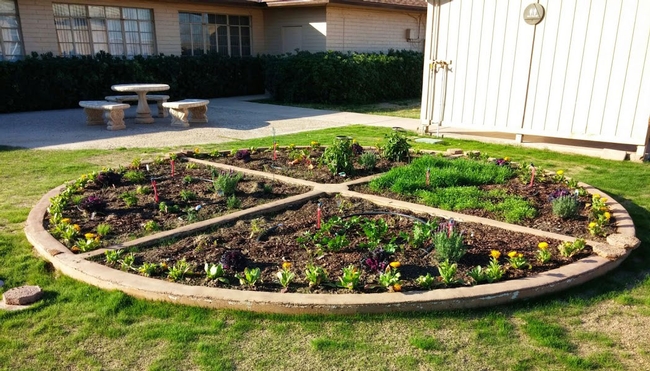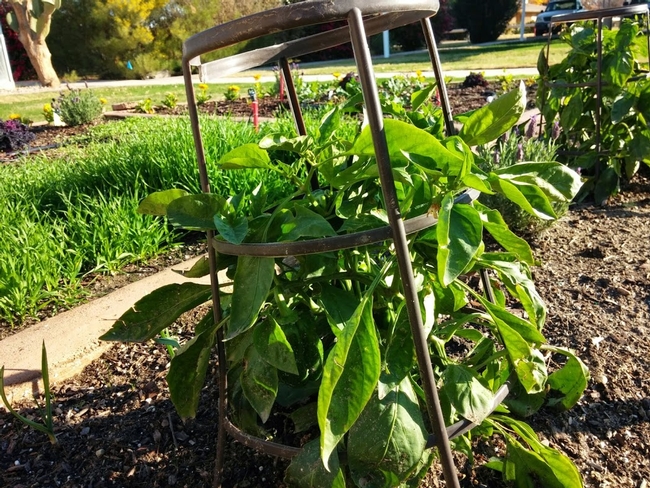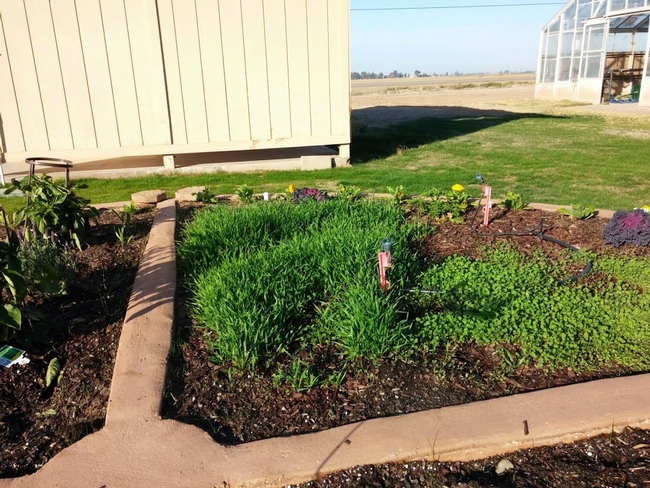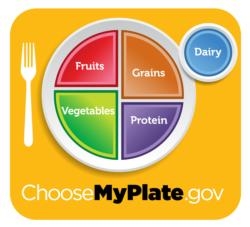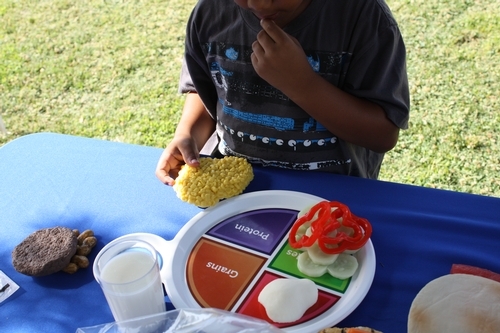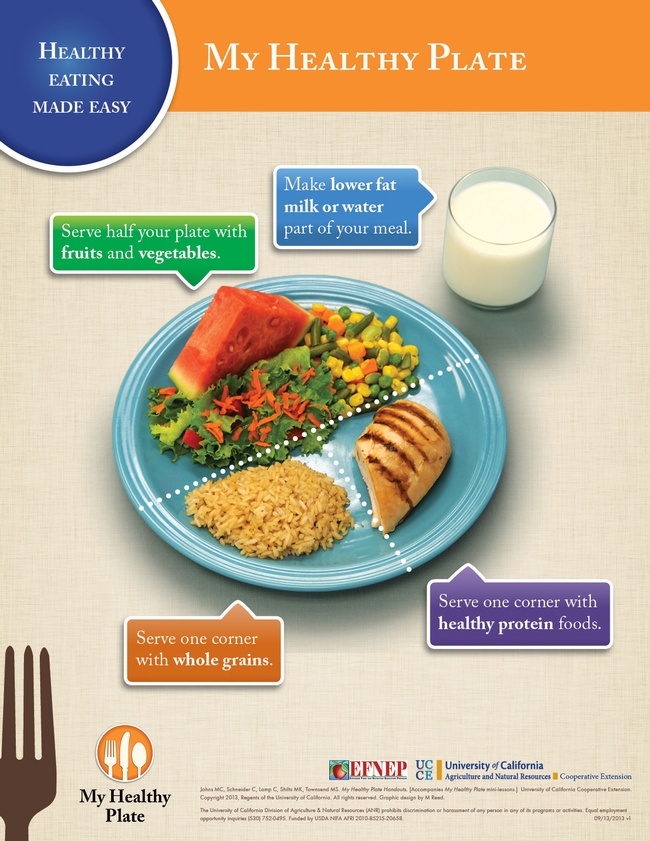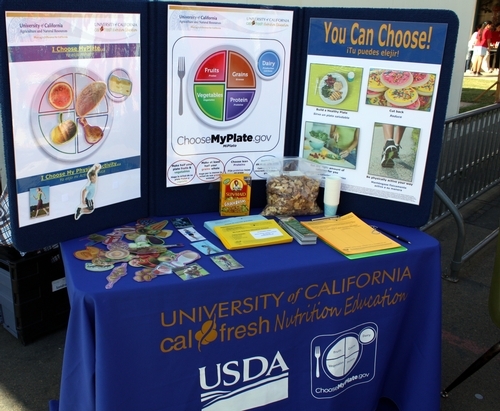UC Food and Agriculture Blogs
Southern Californians get another reason to love pizza
People love pizza, so they are sure to enjoy the new garden growing at the UC Desert Research and Extension Center in Holtville. A circle planted with wheat, tomatoes, bell peppers, herbs and spices, the garden looks like and produces the ingredients for pizza.
“Pizza can be a healthy meal, if you build it right,” said Stephanie Collins, outreach assistant at the Desert REC. “We can teach kids to add vegetables and educate them about whole grains and non-fat cheese.”
Collins initially envisioned the pizza garden teaching tool when she joined UC Cooperative Extension four years ago as a nutrition educator. The recent removal of a large tree stump made the location available.
The pizza garden will be part of the center's UC FARM SMART program, in which about 5,000 school children and “snowbird” winter residents annually visit the station to learn about UC's ongoing agricultural research in the desert area, tour the 255-acre facility on a hay wagon and taste products that are grown in the vicinity.
When they visit the pizza garden, they'll learn many of their favorite foods come from plants grown nearby in the productive agricultural region. The garden is divided into four wedges. The wheat, which is used to make the pizza crust, and alfalfa, which is an important feed for dairy cows, the source of cheese, is grown in one wedge.
“Alfalfa is cheese in the making,” Collins said.
Tomatoes, onions and arugula are planted in the next wedge. The tomatoes are used for traditional sauce and onions are a healthy and flavorful topping, but arugula?
“Arugula is great on pizza,” Collins said. “It has a strong, peppery flavor.”
In another section, visitors can smell, feel and taste the herbs that season pizza sauce. Oregano, basil, sage, thyme, chives, parsley and rosemary fill the third wedge.
The fourth section holds bell peppers and rhubarb.
“The rhubarb is just for fun,” Collins said.
The garden is encircled with marigolds for the appearance of crust, and the wedges are dotted with a variety of non-pizza plants, like ornamental kale, vinca and lavender. These plants also serve an educational purpose, said Sam Urie, the UC FARM SMART manager at the Desert REC.
“A diversity of plants attracts beneficial insects, so they help the garden out,” Urie said.
The mostly senior citizen visitors pay $20 per person for the station tour, which includes a homemade lunch featuring locally produced foods. This year, the centerpiece of the meal will be carrot-ginger soup.
The visitors' fees help offset the cost of the tours for local children, who pay just $3 each.
For more information or to schedule a tour, contact Urie at (760) 791-0261, surie@ucanr.edu.
An initiative to enhance competitive and sustainable food systems is part of the UC Division of Agriculture and Natural Resources Strategic Vision 2025.
Farmer Interview: Jeremy Mineau of Super Tuber Farm
What is something you are enjoying eating from your farm right now? We are just starting to harvest some carrots that have been the ground for a while and I'm really enjoying their sweet flavor. We direct seeded them in the end of August and they are...

Super Tuber!
Exciting job opportunity: Urban IPM Educator
The UC Statewide IPM Program is hiring an Urban IPM Educator to assist with extending pest management information to a variety of urban audiences. This exciting position is perfect for anyone interested in pests, horticulture, teaching, and educating....
New UC IPM Database of Herbicide Symptoms
Identifying nontarget crop and ornamental plant damage from herbicides has become much easier, with the launch of a new online photo repository by the Statewide IPM Program, University of California Division of Agriculture and Natural Resources. Dr....
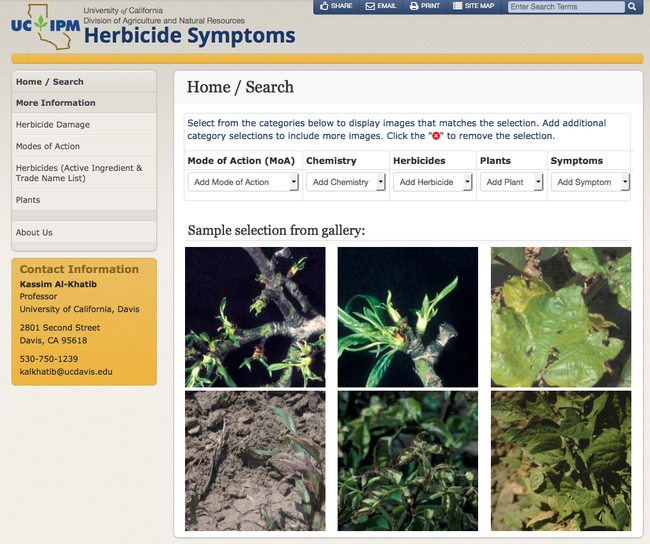
Repository home page. Users can search by by mode of action, herbicide chemistry, herbicide, plant, or damage symptoms.
Picture this: UCCE focuses on healthy meals for Healthy Weight Week (Jan. 18-24)
Photos of sumptuous dishes are nearly as numerous as cat photos on social media. To sharpen people's focus on healthful eating, UC Cooperative Extension nutrition experts are using photos of food.
In 2011, the U.S. Department of Agriculture unveiled a new food graphic, MyPlate, to remind consumers to choose healthier foods. Work by Cooperative Extension in California that began years earlier influenced the adoption of MyPlate by USDA. Nutrition educators in California began using a plate graphic with USDA's My Pyramid several years ago in a research project with Expanded Food and Nutrition Education Program (EFNEP) and UC CalFresh Nutrition Education Program participants. While evaluating the use of their graphic, which was very similar to USDA's MyPlate, UC Cooperative Extension nutrition advisors found that a graphic depiction such as the one USDA is using for MyPlate is abstract for many families.
“We discovered that our clients need to see photos showing real food combinations in order to apply the MyPlate message to real food choices,” said Cathi Lamp, UC Cooperative Extension nutrition advisor. “They prefer to learn by viewing photographs with foods and meals they eat to see how it works and how they can implement the guide in their lives.”
In a project with more than 200 Latino consumers participating, the UCCE nutrition advisors learned which foods Latina, African American and other women would serve their families. Lamp and her colleagues developed materials with photographs of the preferred foods for nutrition education.
They evaluated the behavior of consumers who were trained with the revised Plan, Shop, Save and Cook curriculum with photos of food and compared it with the results of the original version of the lessons.
“We found that the group receiving the revised Plan, Shop, Save and Cook and MyPlate materials reported the greatest change in the frequency of using MyPlate to make food choices, after considering differences among groups in initial behaviors and participant characteristics,” Lamp said.
Given the success of the photographs, UC Cooperative Extension created “My Healthy Plate” posters. Photographs of healthful food served on plates appear in all the EFNEP and UC CalFresh nutrition education materials, including the revised Plan, Shop, Save and Cook curriculum.
“Everybody enjoys looking at pictures of foods,” said Lamp. “So what we have now in our nutrition classes are lots of photographs of healthy examples.”
To listen to an interview with Cathi Lamp about My Healthy Plate in Spanish, visit Enseñando a comer ‘con sabor latino' con MiPlato at http://ucanr.edu/sites/Spanish/Noticias/radio/?uid=5983&ds=199.
For more than 100 years, the University of California Cooperative Extension researchers and educators have been drawing on local expertise to conduct agricultural, environmental, economic, youth development and nutrition research that helps California thrive. UC Cooperative Extension is part of the University of California's systemwide Division of Agriculture and Natural Resources. Learn more at ucanr.edu.



